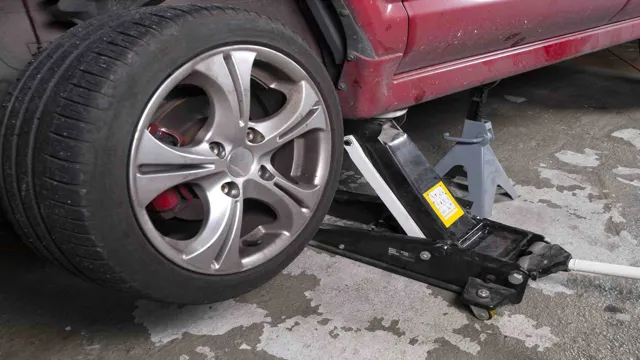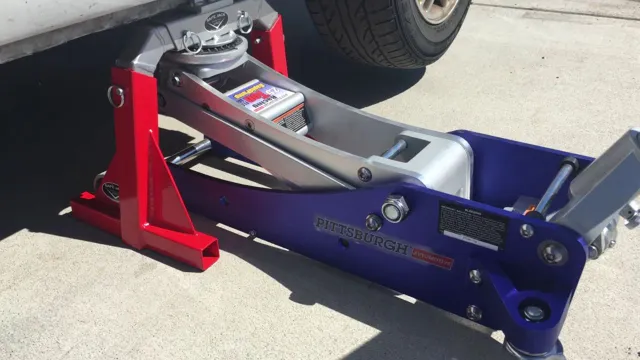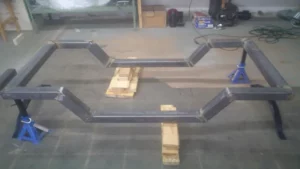Jack stands are an essential tool for any car enthusiast or mechanic who wants to perform any repairs or procedures that require working under a vehicle’s body. However, jacking up a car with jack stands can be a daunting task if you’re new to DIY car maintenance. While jacking up a car with a jack stand may seem simple at first, it is important to follow the correct steps to ensure your safety and the safety of your vehicle.
In this guide, we will go over the steps you need to take to jack up your car safely and reliably with jack stands, so you can work on your car with confidence and peace of mind. So, let’s get started and see how you can jack up your car properly!
Step 1: Park on a Flat Surface
If you’re wondering how to jack up a car with jack stands, the very first step is to park it on a flat surface. This may seem obvious, but it’s important to make sure that your car is parked on an even surface, as this will help to prevent accidents or mishaps when you start lifting it. Even a slight incline or decline can cause the car to shift or roll unexpectedly, which is why it’s essential to park on a flat surface.
Once you’ve found a suitable spot, turn off the engine, engage the parking brake, and put the car in gear (or in neutral, if it’s a manual transmission). Then, place wheel chocks on either side of the wheels that aren’t being lifted to provide extra stability and prevent the car from rolling. With this done, you’re ready to proceed with jacking up the car using your jack stands.
Find a level surface, engage the parking brake, and place the vehicle in gear if it has a manual transmission.
Before performing any maintenance on your vehicle, it’s important to make sure you’re on a flat surface. This will ensure that your vehicle remains steady and stable, reducing the chances of any accidents or injuries. Once you’ve found a level surface, make sure to engage your parking brake.
If you have a manual transmission, place the vehicle in gear to prevent any rolling. By taking these simple precautions, you’ll have the peace of mind knowing that your vehicle is secure and safe while you work on it. So, whether you’re changing a tire or checking your oil, remember to always park on a flat surface, engage your parking brake, and place your vehicle in gear if it has a manual transmission.
This simple step can go a long way in ensuring your safety and the safety of those around you.

Step 2: Locate the Jack Points
Once you have found a safe and flat surface to jack up your car with jack stands, the next step is to locate the jack points. These are the specific areas of your vehicle designed to handle the weight of the car while being lifted. Consulting your car manual is paramount in locating the exact points as they differ for different car models.
Most cars utilize four jack points: two at the front and two at the back. Typically, they are located behind the front wheels and in front of the back wheels, near the vehicle’s frame. It’s important to avoid lifting the car on any other part of the vehicle, as it may cause damage and potentially dangerous situations.
Once you’ve located precisely where the car’s jack points are situated and checked them for damage, you’re ready to proceed with the next step.
Refer to your car’s owner manual to locate the recommended jacking points.
When it comes to jacking up your car, it’s essential to locate the correct jacking points to ensure that you don’t cause any damage to your vehicle. To avoid potential disaster, the best place to look for guidance is in your car’s owner manual. The manual should provide you with detailed instructions on where the optimal jacking points are.
Some cars have specific markings on the underbody to indicate where the jack should be placed, while others have obvious reinforced areas where the jack can be safely positioned. In any case, referring to your car manual is the best starting point when it comes to locating the recommended jacking points. Failing to follow these guidelines could result in damage to your car and possibly cause injury to you or others.
So to avoid any such incidents, always take the time to read through the manual and locate the jacking points before attempting to raise the vehicle.
Step 3: Lift the Car with the Jack
Now that you’ve positioned your jack stand in the desired location, it’s time to lift your car. Apply small, even pressure on the jack handle to start lifting the car. Keep an eye on your car to make sure it’s lifting evenly.
If one side starts looking higher than the other, stop immediately and adjust the jack. Also, keep in mind that you should never place any body parts under the car while lifting it with the jack. Once your car is high enough, slowly lower it onto the jack stand.
Be sure the stand is level and stable before fully releasing the jack. Congratulations, you’ve successfully lifted your car with jack stands! It’s important to always perform regular maintenance on your vehicle and be cautious while working beneath it, so always keep your jack stands handy and in good condition for any necessary repairs.
Insert the jack under the jacking point and lift up the car following the jack instructions.
When it comes to lifting your car with a jack, safety should always be your top priority. Before lifting your vehicle, make sure you have properly placed the jack under the recommended jacking point, which is usually indicated in your car’s manual. Once you have located the jacking point, insert the jack and follow the instructions provided.
Crank the handle slowly until the car starts to lift up off the ground. Keep an eye on the car as it lifts, ensuring that it stays centered and straight. Once the car is suspended off the ground, confirm that it is stable and secure before beginning any work.
Remember that any sudden movements or jolts can cause the car to topple off the jack, resulting in serious injury or damage. Proceed with caution and take the time to double-check your work. By following these simple steps, you can safely and effectively lift your car with a jack and perform any necessary maintenance or repairs.
Step 4: Place the Jack Stands
Now that your car is safely jacked up, it’s time to secure it with jack stands. These stands provide additional stability to keep your car from falling while you work on it. Before placing the stands, make sure to consult your owner’s manual to find the recommended jack points for your specific vehicle.
Place the jack stands directly beneath these points and make sure they are level and stable. Double check that the car is properly balanced on the stands by gently rocking it before getting underneath. Once you’re confident the car is safely secured, you’re ready to start working on it.
Remember, always prioritize your safety when working on any car.
Position the jack stands under the recommended safety point locations and lock them in place.
When it comes to safely lifting a vehicle, positioning the jack stands correctly is crucial. To begin, locate the recommended safety point locations in your vehicle’s owner’s manual. These locations are typically indicated by a small notch or groove in the frame of the car.
Once you have identified these points, position the jack stands directly underneath them. Make sure the stands are level and secure before locking them in place. It’s a good idea to give the car a gentle push or rock to ensure it’s stable before continuing your work.
Remember, never rely solely on a jack to hold up a car, as it can easily slip or fail. Jack stands are a critical safety component for any repair or maintenance work, and taking the time to position them correctly can prevent accidents and injury. So, take the time to ensure your jack stands are properly secured before getting under your car.
Your safety, and the safety of those around you, depends on it.
Step 5: Lower the Car onto the Jack Stands
When it comes to jacking up a car with jack stands, the final step is just as important as the others. Lowering the car onto the jack stands must be done with caution and precision, as any misstep could result in serious injury or damage to the vehicle. To start, make sure that the car is properly balanced on the jack stands and that the stands are securely in place.
Next, slowly and carefully lower the car until it rests fully and evenly on the stands. It’s a good idea to give the car a gentle shake to ensure that it’s stable before continuing any work on it. Remember, safety always comes first when working with cars, so take your time and stay attentive throughout the entire process.
By following these steps, you can jack up your car with jack stands safely and effectively, allowing you to tackle a variety of DIY maintenance and repair tasks with confidence.
Slowly lower the car onto the jack stands, making sure it is secure.
When it comes to lifting your car onto jack stands, safety is the utmost priority. After positioning the jack stands and double-checking that they are stable, the next step is to slowly lower your car onto them. This can be nerve-wracking, but with patience and care, it can be done easily.
First, ensure that your car is in gear or park, and the emergency brake is engaged. Then, place the jack stand in line with the reinforced sections underneath your car’s frame. Using the jack, lift the car until it reaches a height where you can safely remove the floor jack from underneath.
Finally, release the floor jack and begin to slowly lower the car onto the jack stands, ensuring that it is secure. Once the car is safely resting on the stands, give it a gentle push to make sure it’s stable. Remember, it’s always better to be safe than sorry, so don’t rush the process.
Taking the time to do it right can save you from a catastrophic accident.
Step 6: Test Stability
Once you have successfully jacked up your car with jack stands, the next step is to test the stability of the vehicle. This is crucial to ensure the safety of both you and your vehicle. To perform the stability test, try gently shaking the car from both sides.
If you notice any wobbling or instability, then there’s a good chance that your jack stands aren’t properly positioned. In that case, you’ll need to redo the entire jacking up process with extra care. It’s important not to rush this step and to double-check everything to avoid any accidents.
With a stable and secure car, you can safely perform any repairs or maintenance that you need without worrying about any accidents or injuries. So, take your time and make sure the vehicle is stable and secure before getting started.
Try to shake the vehicle to ensure that the jack stands are holding it firmly.
When you’re changing a tire or doing other repairs on your vehicle, it’s important to make sure that the jack stands are holding the weight of the vehicle securely. Step 6 of this process is to test the stability of the vehicle by giving it a good shake. This will help you identify any wobbling or shifting that could indicate that the jack stands are not holding the vehicle properly.
If you do detect any movement, stop immediately and reposition the jack stands until the vehicle is firmly supported. Another helpful tip is to try shifting your weight around the vehicle while it’s up on the jack stands. This will help you get a sense of whether the vehicle is likely to tip or topple while you’re working on it.
By taking these steps, you can ensure that you’re working safely and confidently on your vehicle.
Step 7: Remove the Jack
Now that you’ve successfully lifted your car onto jack stands, it’s time to remove the jack. This step is essential since leaving the jack in place while working on your car is incredibly dangerous and can result in serious injury or even death. To remove the jack, you’ll need to locate the jack’s point of contact and gently lower it while keeping a firm grip on the jack handle.
Once you’ve lowered the jack, slowly slide it out from under your car. Remember always to be cautious and take your time during this step to avoid any accidents. Congrats, You’ve now jacked up your car with jack stands and are ready to start working on your vehicle!
Carefully remove the jack and recheck the stability of the car on the jack stands.
Carefully removing the jack is the next crucial step in ensuring a stable car on jack stands. Once you have tighted the lug nuts, it’s time to lower the jack, but do it slowly and carefully. Any sudden movement could cause a dangerous situation.
Place your hand on the car and gently shake it to see if everything feels secure. If the car feels stable, it’s time to remove the jack. Lift the jack and slowly maneuver it out from underneath the car.
Always pay close attention to the car’s position, as any slight movement can throw it off balance. Once the jack is safe and secure, recheck the stability of the car on the jack stands. It’s important to take your time and follow all the steps carefully.
Rushing through the process can put yourself and others in danger. Remember to be diligent, and the process will be smooth and straightforward.
Conclusion
So, the next time you need to jack up your car, remember these simple steps: find a level surface, grab a trusty jack, position your jack stands, and secure them in place. And for all those who think they can simply use cinder blocks and old textbooks to prop up their car – think again! Keep your car and yourself safe by following proper jack stand protocol. Because let’s face it, there’s nothing witty or clever about a car falling on top of you.
“
By following these steps, you will be able to safely jack up a car with jack stands.
Now that your car is safely mounted on jack stands, it’s time to remove the hydraulic jack. This process is simple, but it requires patience and care. To remove the jack, start by retracting the hydraulic arm until it’s flush with the base of the jack.
Then, use the release valve to slowly lower the arm back into its starting position. This will take some time, as you want to make sure that the arm is fully lowered and the car is stable on the jack stands. Once the arm is safely back in place, give your car a gentle shake to ensure that it’s securely resting on the stands.
If everything feels stable, you can move on to your repairs or maintenance knowing that you’ve taken the necessary steps to ensure your safety. Remember, safety always comes first!
FAQs
What are jack stands and how do they work when jacking up a car?
Jack stands are supports used to elevate a car and keep it stable while you work underneath it. To use them, first jack up the car with a hydraulic floor jack, then place the jack stands under the frame or designated jack points. Adjust the height of the stands so they fit snugly and securely under the car.
How many jack stands do I need to safely lift a car?
You should always use at least two jack stands when lifting a car. This ensures proper weight distribution and stability while you work.
How high should I set my jack stands when lifting my car?
The height of your jack stands will depend on the size of your car and the work you’re doing. Consult your owner’s manual for the proper jacking points and recommended stand height. In general, the stands should be set just high enough to provide enough space for you to work safely underneath the car.
Can I use any type of jack stand for my car?
No, it’s important to use the appropriate type of jack stand for your car. Look for stands with weight ratings that will safely support the weight of your car, and consider the type of surface you’ll be working on (concrete, gravel, etc.) when selecting your stands.
Are there any safety tips I should follow when using jack stands?
Absolutely. Always use jack stands on a flat, stable surface and ensure they are correctly positioned and adjusted before beginning work. Never go underneath a car that is only supported by a jack–always use jack stands as an extra layer of safety. Finally, make sure you properly maintain your jack stands by inspecting them regularly for damage or wear.
Can I use jack stands on a sloped driveway?
It’s generally not recommended to use jack stands on a sloped driveway, as the car can shift or roll off the stands. If it’s absolutely necessary, consult a professional mechanic or car expert for advice on how to safely lift your car in this situation.
Do I need to chock the wheels when using jack stands?
Yes, in order to prevent the car from rolling forward or backward, it’s always a good idea to chock the wheels opposite of the ones you are lifting. This added safety measure ensures maximum stability while you work underneath the car.






